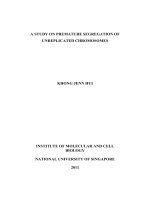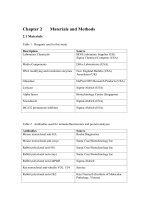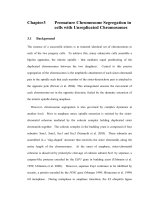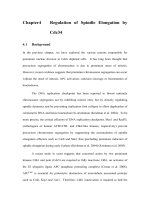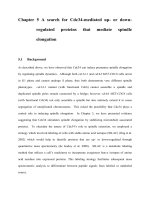A study on prevalence of microorganisms on surface of Brinjal (Solanum melongena L.) collected from local market yards across Junagadh district, India
Bạn đang xem bản rút gọn của tài liệu. Xem và tải ngay bản đầy đủ của tài liệu tại đây (168.96 KB, 8 trang )
Int.J.Curr.Microbiol.App.Sci (2019) 8(4): 2424-2431
International Journal of Current Microbiology and Applied Sciences
ISSN: 2319-7706 Volume 8 Number 04 (2019)
Journal homepage:
Original Research Article
/>
A Study on Prevalence of Microorganisms on Surface of Brinjal
(Solanum melongena L.) Collected from Local Market Yards across
Junagadh District, India
Kajal Girdharbhai Kothadiya*
College of Veterinary Science and Animal Husbandry, Anand Agricultural University,
Anand 388110, Gujarat, India
*Corresponding author
ABSTRACT
Keywords
Microbial load,
Prevalence, Total
plate count (TPC),
Post-harvest
treatment and Food
spoilage
Article Info
Accepted:
17 March 2019
Available Online:
10 April 2019
Brinjal (Solanum melongena L.) is an important solanaceous crop of sub-tropics and
tropics. The Brinjal is being grown extensively in India. All vegetables have been known
to serve as vehicles of human disease for at least a century. Vegetables can become
contaminated with microorganisms capable of causing human diseases. This study was
designed to determine the microbial load and prevalence of pathogens on surface of Brinjal
in local market yards across Junagadh district. Brinjal samples were collected from the
four talukas of Junagadh district (Visavadar, Mendarda, Vanthali and Junagadh) in two
subsequent round and microbial load was assessed using different selective media for the
growth of bacteria and fungi. Total plate count (CFU/gm) was highest in Mendarda local
market yard samples which was 30 x 10 4 CFU/gm and lowest in Junagadh local market
yard sample respectively. Yeast & mold count on Brinjal was found up to 13 x 104
CFU/gm for market yards of Junagadh district. Prevalence of E. Coli, Salmonella and
Vibrio were observed in most of the samples collected form market yards could pose a
health risk to consumers in the country. These high viable counts of microorganisms on
Brinjal, could be because of unhygienic handling condition of local market, inappropriate
transportation facility, improper storage condition etc. This can be reduce up to certain
extent by giving suitable post-harvest treatment which can reduce food spoilage while
maintaining sensory and nutritional characteristics of the fruits and vegetables.
Introduction
India's diverse climate ensures availability of
all varieties of fresh fruits and vegetables. It
ranks second in fruits and vegetables
production in the world, after China.
(National Horticulture Database published by
National Horticulture Board, during 2015-16,
/>oduct/FFV.htm). Fruits and vegetables are the
most perishable agricultural produces and the
post-harvest loss of these is tremendous. Raw
vegetables and fruits have been known to
serve as vehicles of many diseases for at least
a century. Surface flora of vegetables may
come from fields or orchards or during
2424
Int.J.Curr.Microbiol.App.Sci (2019) 8(4): 2424-2431
harvesting, transport, processing, distribution
and marketing. Bacteria such as Clostridium
botulinum, Listeria monocytogenes, Bacillus
cereus etc. all are capable of causing illness
and are normal inhabitants of soils, whereas
Escherichia coli, Shigella, Salmonella,
Campylobacter etc. reside in the intestinal
tracts of humans and are more likely to
contaminate vegetables through contact with
sewage, feces, untreated irrigation water.
Contamination may also occur during postharvest handling, including at points of
preparation by street vendors, in food-service
establishments and in the home (Cliver, 1997;
Speer, 1997).
Brinjal or eggplant (Solanum melongena L.) is
an important solanaceous crop of sub-tropics
and tropics. The Brinjal is of much
importance in the warm areas of Far East,
being grown extensively in India, Bangladesh,
Pakistan, China and the Philippines. It is also
popular in Egypt, France, Italy and United
States. India is considered to be the Centre of
Origin of cultivated eggplant, from where it
spread to the other parts of the world
(Choudhury and Malda, 1968). In India it is
the one of the most common and valuable
vegetable (Sekara et al., 2007) and due to its
wide usage in Indian foods it is described as
“king of vegetables” (Choudhary and Gaur,
2009; Singh et al., 2014). It is primarily
consumed as cooked vegetable in various
ways and dried shoots are used as fuel in rural
areas. It is low in calories and it contains
mostly water, carbohydrate, protein, fibre,
anthocyanin, phenols, glycoalkaloids etc. It is
a good source of minerals and vitamins and is
rich in reducing sugars, amide proteins among
other nutrients (Bajaj et al., 1979; Kalra, et
al., 1988). Brinjal is known to have ayurvedic
medicinal properties and is good for diabetic
patients. It has also been recommended as an
excellent remedy for those suffering from
liver complaints (Shukla and Naik, 1993).
Raw and minimally processed vegetables like
Brinjals are an essential part of people‟s diet
all around the world. Many advances in
agronomic processing, practices, preservation,
marketing and distribution have supported the
raw vegetable industry to supply high-quality
produce to many consumers all year round,
some of these same practices have also
expanded the geographical distribution and
incidence of human illness associated with an
increasing number of pathogenic bacterial,
viral and parasitic microorganisms. Most of
the contaminating flora is non pathogenic and
has a natural occurrence on the produce.
However, pathogens from the human and
animal reservoir as well as other pathogens
from environment can be found at the time of
consumption. The survival of enteric
pathogens in soil, manure, municipal wastes
and irrigation water depends on different
factors like relative humidity, microbial
adhesion, rainfall, sunlight, etc. (De Rover,
1998). Exposure to non-pathogenic bacteria
associated with plants may influence the
development of allergies and the consumption
of raw produce may represent an important
means by which new lineages of commensal
bacteria are introduced into the human
gastrointestinal system (Hanski, 2012). The
contamination of fruits and vegetables by
bacteria could also be as a result of poor
handling practices in food supply chain,
storage conditions, distribution, marketing
practices and transportation. Several studies
have been carried out in many countries to
determine the presence of pathogenic
microorganisms on raw fruits and vegetables.
In many instances, high percentages of
samples have been found to contain
microorganisms capable of causing human
disease. To prevent contamination of
vegetables during production, transport,
processing and handling, much improvement
is still needed if hygienic condition of
vegetables is to be ensured. Furthermore,
many microbial contaminants are part of the
environment and vegetables may be
2425
Int.J.Curr.Microbiol.App.Sci (2019) 8(4): 2424-2431
inadvertently contaminated. The purpose of
this work is to study the distribution and
prevalence of microorganisms on the surface
of Brinjal from the Junagadh district. It will
help to design post-harvest treatment or
surface decontamination treatment for the
reduction of surface microbial flora from
vegetable surface.
Materials and Methods
Sample collection
The Brinjal samples were collected from
different local vegetable market yards of
Junagadh district (Visavadar, Mendarda,
Vanthali and Junagadh talukas). Three
samples were collected twice at an interval of
fifteen day's in sterile plastic bags from each
market yard. After collections, samples were
kept in proper container to transport from
market yard to laboratory.
pure culture such as colony form, elevation of
colony and colony margin were observed.
Microbial identification was done based on
the method given by Jolt et al., (1994).
Microbial load determination
Bacterial quantification was done after 24 hrs
of incubation from nutrient agar plates.
Whereas yeast and mold count was done after
3-4 days of incubation from potato dextrose
agar plates. Plates with 30 to 300 colonies
were selected for quantification. Total number
of microorganisms was calculated by using
following formula:
Total number of microorganisms =
Number of colony * Dilution factor
Volume plated
Surface decontamination of Brinjal sample
Sample processing
microorganisms
and
isolation
of
One grams of Brinjal surface was pilled from
each of sample by sterilized knife and added
to 9 ml sterile distilled water to make 10-1
dilution. Then serial dilution upto 10-7 were
carried out. 0.1 ml from each dilution was
spread on N-agar and Potato Dextrose agar
plate for total bacterial and mould count
respectively. 0.1 ml from 10-1 dilution used
for Eosin Methylene Blue and Vibrio agar
media for E. coli and Vibrio spp. respectively.
1 ml from 10-1 dilution was added to Fluid
Selenite Cystine broth (FSC) for Salmonella
enrichment and after 24 hrs. enriched FSC
broth were transferred on Xylose Lysine
Deoxycholate (XLD) agar for their selective
isolation. These agar plates were incubated
for 24 hrs at 37°C for colony formation. Each
colony was isolated in a pure form for further
studies and identification by sub-culturing.
Distinctive morphological properties of each
Surface decontamination of Brinjal sample
was studied with water and neem leaf extracts
wash. Collected Brinjal sample was dipped
(for 5 minutes) and gently washed with water.
Same way, Brinjal sample was dipped (for 5
minutes) and gently washes with Neem leaf
water extracts. These washed samples were
studied with control sample (unwashed
sample) for Total plate count, Yeast and Mold
count, E. coli, Vibrio and Salmonella spp.
Results and Discussion
Fruits and vegetables harbor a wide range of
microbial contaminants as reported by Long
et al (2002). The major bacterial populations
that are generally present on fruits and
vegetables include species of Pseudomonas
spp., Bacillus spp., Enterobacter spp., Sarcina
spp., Staphylococcus spp., Streptococcus spp.,
Lactobacillus spp. and Leuconostoc spp. as
stressed by Erin (2010). Most of the
2426
Int.J.Curr.Microbiol.App.Sci (2019) 8(4): 2424-2431
vegetables were not really fresh as they stayed
in the market for long periods resulting to
their spoilage (Sahin et al., 1997). To evaluate
microbial load of on Brinjal samples it was
collected from four randomly selected market
yards of Junagadh district at different time
interval and analyzed for various parameters
as below.
Total Plate Count
Yeast and Mold Count
Qualitative detection of E. coli
Qualitative detection of Salmonella spp.
Qualitative detection of Vibrio cholera.
Surface decontamination of Brinjal
Total plate count of Brinjal
Total plate count of Brinjal collected from
Market yards of Junagadh District was in the
range of 4 x 104 to 42 x 104 cfu/gm (Table 1).
Out of the four market yard samples of
Junagadh district, highest total plate count
observed from Vanthali and lowest total plate
count observed Junagadh market yard (Fig.
1).
Table.1 Microbial load of Brinjal samples collected from different market yard
of junagadh district
No
Place
1
2
3
4
Visavadar
Mendarada
Vanthali
Junagadh
TPC Mean
Value (X 104)
15
42
10
4
Y/M Mean
Value (X 104)
3
3
1
3
E. coli Salmonella
(%)
(%)
17
83
67
83
50
0
83
50
Vibrio
(%)
50
0
33
33
Table.2 Microbial load of Brinjal sample treated with water and Neem leaf wash
Sample
Control
Water Wash
Neem Leaf Wash
TPC
12X104
6X104
2X104
Y/M
154X102
12X102
8X102
E.coli
Present
Present
Absent
Salmonella
Present
Present
Present
Vibrio
Present
Present
Present
Fig.1 Total plate count of Brinjal from different market yard of Junagadh district
Total Plate Count
CFU/g (x 10000)
No
1
2
3
45
40
35
30
25
20
15
10
5
0
Visavadar
Mendarada
Vanthali
Local market yard of Junagadh district
2427
Junagadh
Int.J.Curr.Microbiol.App.Sci (2019) 8(4): 2424-2431
Fig.2 Yeast and Mold Count of Brinjal samples collected from different market
yard of Junagadh district
Yeast and Mold Count
3.5
CFU/g (x 10000)
3
2.5
2
1.5
1
0.5
0
Visavadar
Mendarada
Vanthali
Junagadh
Local market yard of Junagadh district
Fig.3 Presence of E. coli on Brinjal samples collected from different market yard of Junagadh
district
E. coli Count
90
80
%
70
60
50
40
30
20
10
0
Visavadar
Mendarada
Vanthali
Junagadh
Local market yard of Junagadh district
Fig.4 Presence of Salmonella spp. on Brinjal samples collected from different market yard of
Junagadh district
Salmonella Count
90
%
80
70
60
50
Series1
40
30
20
10
0
Visavadar
Mendarada
Vanthali
Local market yard of Junagadh district
2428
Junagadh
Int.J.Curr.Microbiol.App.Sci (2019) 8(4): 2424-2431
Fig.5 Presence of Vibrio spp. on Brinjal samples collected from different market yard of
Junagadh district
Vibrio Count
60
50
%
40
30
20
10
0
Visavadar
Mendarada
Vanthali
Junagadh
Local market yard of Junagadh district
Yeast and mold count of brinjal
Yeast and Mold count of Brinjal collected
from Market yards of Junagadh District was
in the range of 1 x 104 to 3 x 104 cfu/gm
(Table 1 and 2). Out of the four market yard
samples of Junagadh district, Visavadar,
Mendarada and Junagadh Market yard has
Yeast and Mold count was around 3 x 104
cfu/gm. Vanthali was found with the lowest
Yeast and Mold count which was around 1 x
104 cfu/gm (Fig. 2).
Qualitative detection of E. coli
E. coli % of Brinjal samples collected from
different market yard of Junagadh district was
observed in the range of 17 – 83 % (Fig. 3).
Out of the four market yard samples,
Junagadh market yard showed highest
presence of E.coli while samples collected
from Visavadar market yard showed lowest
contamination of E.coli.
yard samples, Brinjal samples collected from
the Visabadar and Mendarada market yard
showed highest presence of Salmonella spp.
however, it was not observed or absent in
Vanthali market yard.
Qualitative detection of Vibrio cholerae
Vibrio cholerae % of Brinjal samples
collected from different market yard of
Junagadh district were observed in the range
of 0 – 50 % (Fig. 3). Out of the four market
yard samples, Brinjal samples collected from
the Visabadar showed highest presence of
Vibrio cholerae, however, it was not observed
or absent in Mendarada market yard.
Surface decontamination of brinjal sample
Brinjal samples washed with water and Neem
leaf extracts shows that the TPC, Y/M Count
and E. Coli decrease gradually with water
wash and neem water wash, while no changed
occur in Vibrio Spp. and Salmonella typhi.
Qualitative detection of Salmonella spp.
Salmonella spp. % of Brinjal samples
collected from different market yard of
Junagadh district were observed in the range
of 0 – 84 % (Fig. 3). Out of the four market
In conclusion, this comprehensive study was
undertaken to detect the microbial load and
prevalence of pathogens on Brinjal surface.
The Brinjal samples were collected from four
talukas of Junagadh distrct (Visavadar,
2429
Int.J.Curr.Microbiol.App.Sci (2019) 8(4): 2424-2431
Mendarda, Vanthali, Junagadh). These
samples were studied for TPC, YMC and
prevalence of E. coli, Salmonella typhi and
Vibrio spp. Study shows that Brinjal samples
collected from Local Market yard were
harboring high microbial load with
pathogenic microbial species. This could pose
health risk to consumers. Source of microbial
contamination of Brinjal samples may be
from handling, source of water, local market
yard, packaging, storage and transportation.
In India majority of the people preferred to
buy fresh vegetables from the Local Market.
So, it is necessary to maintain good hygienic
condition while handling, transport, storage,
so risk of contaminants can be decreases and
chances of food borne outbreaks can be
minimized. Good hygienic condition can also
be increased by pre-treatment of fresh
produce by various anti-microbial agents to
decrease the microbial load from the surface
of the fresh produce.
References
Bajaj, K. L., Kaur, G., and Chadha, M. L.
1979. Glyco alkaloid content and
other chemical constituents of the
fruits of some eggplant (Solanum
melongena L.) varieties. Journal of
Plant Foods. 3(3): 163-168.
Choudhary, B., and Gaur, K. 2009. The
development and regulations of Bt
brinjal in India. ISAAA Brief, 38.Pp.
1- 2.
Choudhury, B., and Malada, T. S. 1968.
Brinjal: A vegetable of masses. Indian
Horticulture. 12: 21-22.
Cliver, D. O. 1997. Foodborne viruses In:
Food Microbiology: Fundamentals
and Frontiers (Eds.), M.P., Doyle,
L.R., Beuchat and T. J., Montville.
Washington, DC, American Society
for Microbiology. Pp. 437-446.
De Rover, C. 1998. Microbial safety
evaluations and recommendations on
fresh produce. Food Control. 9(6):
321-347.
Erin, S. 2010. Influence of pre-harvest factor
on postharvest quality. Biochemistry.
2: 133-145.
Hanski, I., Von Hertzen, L., Fyhrquist, N.,
Koskinen
K.,
and
Torppa, K.
Laatikainen, T., Karisola, P., Auvinen,
P., Paulin, L., Makela, M., Vartiainen,
E., Kosunen, T., Alenius, H.,
Haahtela, T. 2012. Environmental
biodiversity, human microbiota and
allergy are interrelated. Proceedings of
the National Academy of Sciences,
USA, 109: 8334-8339.
Jolt, J. G., Krieg, N. R., Sneath, P. A.,
Stanley, J. T., and Williams, S. T.
1994. Bergey‟s manual of systematic
bacteriology, 9th edition. Williams and
Wilkins Co. Baltimore, Maryland. Pp.
786.
Kalra, C. L., Berry, S. K., and Sehgal, R. C.
1988. A resume on brinjal (Solanum
melongena L.), a most common
vegetable. Indian Federation Packer.
42: 46-59.
Long, S. M., Adak, G.K. O'Brien, S. J., and
Gillespie,
I.
A.
2002. General
outbreaks of infectious intestinal
disease linked with salad vegetables
and fruit, England and Wales, 19922000. Communicable disease and
public Health. 5: 101-105.
Sahin, F., and Miller, S. A. 1997. A source of
resistance in Capsicum spp. accessions
to pepper race 6 of Xanthomonas
campestris pv. vesicatoria.
Phytopathology. 87: S84-S84.
Sekara, A., Cebula, S., and Kunicki, E. 2007.
Cultivated eggplants
– origin,
breeding objectives and genetic
resources:
A
review.
Folia
Horticulturae, 19: 97−114.
Shukla, V., and Naik, L. B. 1993. Agro
techniques of solanaceous vegetables,
in „Advances in Horticulture‟, Vol.5,
2430
Int.J.Curr.Microbiol.App.Sci (2019) 8(4): 2424-2431
Vegetable Crops, Part 1 (K. L. Chadha
and G. Kalloo, eds.), Malhotra Pub.
House, New Delhi. 365.
Singh, B. K., Singh, S., Singh, B. K., and
Yadav, S. M. 2014. Some important
plant pathogenic disease of Brinjal and
their management. Plant Pathology
Journal. 13 (3): 208-213.
Speer, C. A. 1997. Protozoan parasites
acquired from food and water In: Food
Microbiology: Fundamentals and
Frontiers (Eds.), M.P., Doyle, L.R.,
Beuchat and T. J., Montville.
Washington, DC, American Society
for Microbiology. Pp. 478-493.
How to cite this article:
Kajal Girdharbhai Kothadiya. 2019. A Study on Prevalence of Microorganisms on Surface of
Brinjal (Solanum melongena L.) Collected from Local Market Yards across Junagadh District,
India. Int.J.Curr.Microbiol.App.Sci. 8(04): 2424-2431.
doi: />
2431




